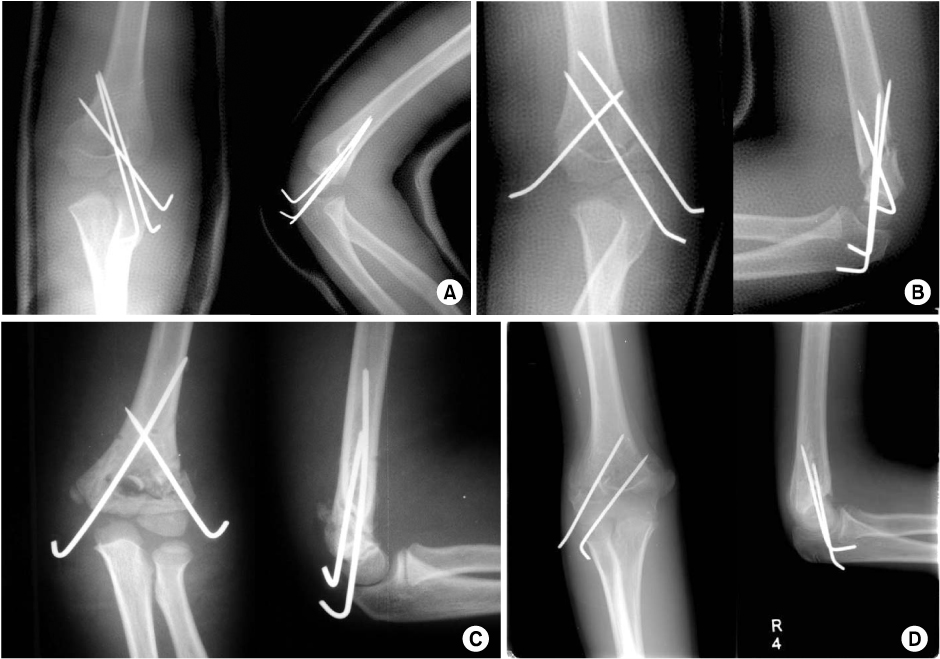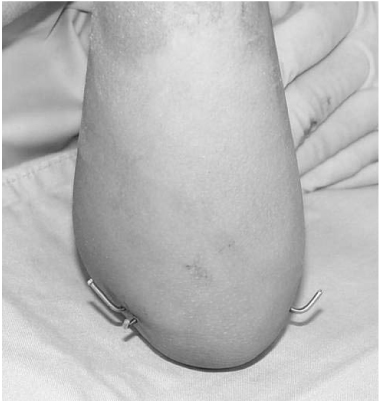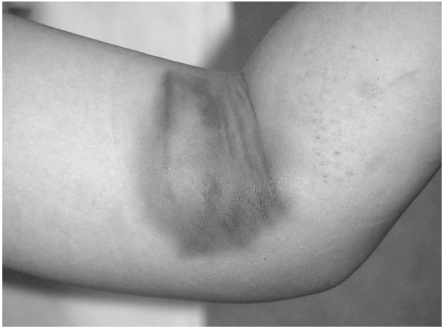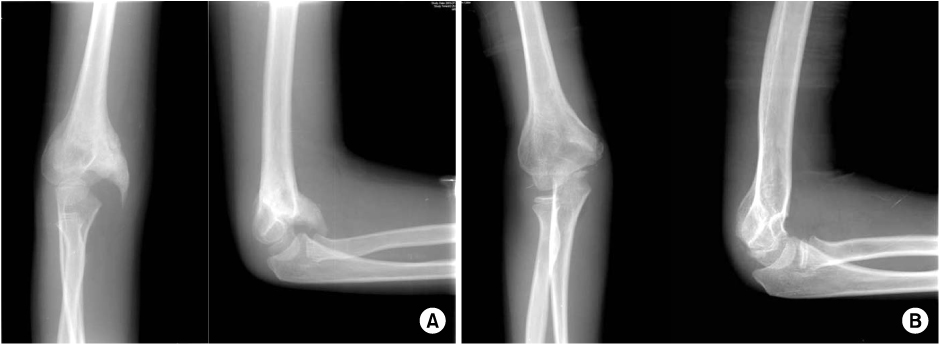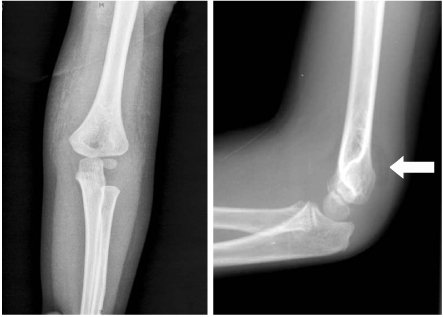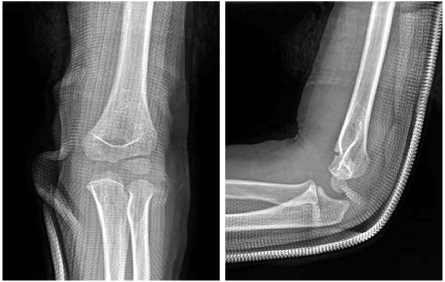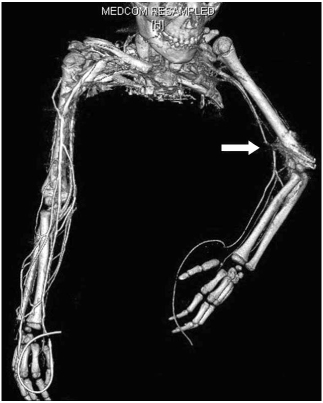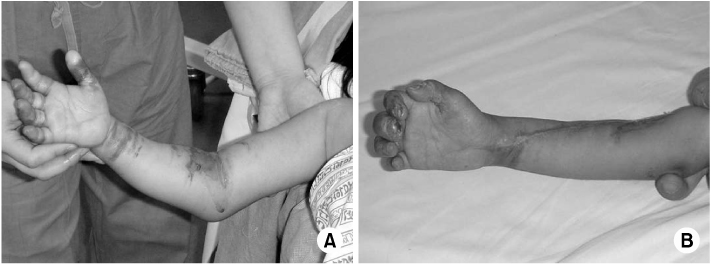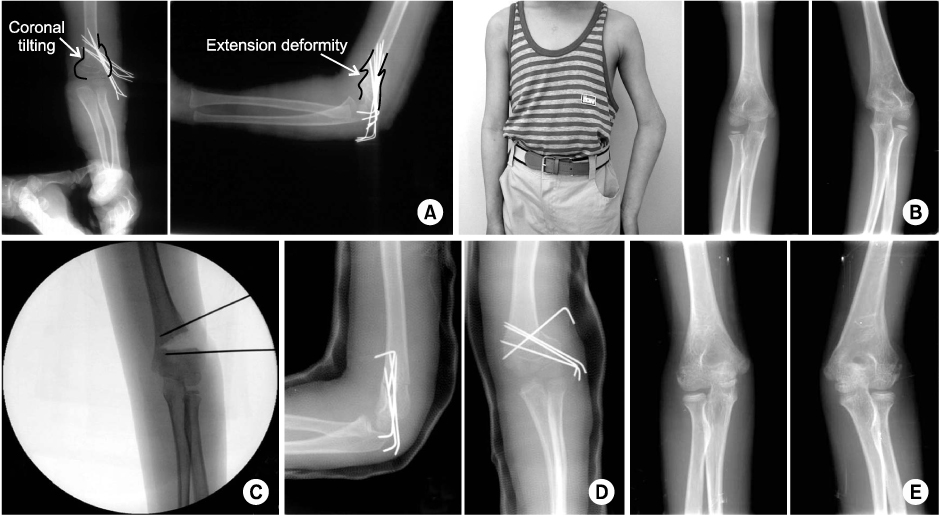J Korean Fract Soc.
2012 Jan;25(1):82-93. 10.12671/jkfs.2012.25.1.82.
Recent Trends in Treatment of Supracondylar Fracture of Distal Humerus in Children
- Affiliations
-
- 1Department of Orthopaedic Surgery, Samsung Medical Center, Sungkyunkwan University School of Medicine, Seoul, Korea. jss3505@skku.edu
- KMID: 1434117
- DOI: http://doi.org/10.12671/jkfs.2012.25.1.82
Abstract
- No abstract available.
Figure
Cited by 1 articles
-
Surgical Timing of Treating Pediatric Trauma: Urgencies/Emergencies
Chang-Wug Oh, Joon-Woo Kim, Jong-Chul Lee
J Korean Fract Soc. 2015;28(2):146-154. doi: 10.12671/jkfs.2015.28.2.146.
Reference
-
1. Aktekin CN, Toprak A, Ozturk AM, Altay M, Ozkurt B, Tabak AY. Open reduction via posterior triceps sparing approach in comparison with closed treatment of posteromedial displaced Gartland type III supracondylar humerus fractures. J Pediatr Orthop B. 2008. 17:171–178.
Article2. Babal JC, Mehlman CT, Klein G. Nerve injuries associated with pediatric supracondylar humeral fractures: a meta-analysis. J Pediatr Orthop. 2010. 30:253–263.
Article3. Barrett IR, Bellemore MC, Kwon YM. Cosmetic results of supracondylar osteotomy for correction of cubitus varus. J Pediatr Orthop. 1998. 18:445–447.
Article4. Belhan O, Karakurt L, Ozdemir H, et al. Dynamics of the ulnar nerve after percutaneous pinning of supracondylar humeral fractures in children. J Pediatr Orthop B. 2009. 18:29–33.
Article5. Blakey CM, Biant LC, Birch R. Ischaemia and the pink, pulseless hand complicating supracondylar fractures of the humerus in childhood: long-term follow-up. J Bone Joint Surg Br. 2009. 91:1487–1492.6. Brauer CA, Lee BM, Bae DS, Waters PM, Kocher MS. A systematic review of medial and lateral entry pinning versus lateral entry pinning for supracondylar fractures of the humerus. J Pediatr Orthop. 2007. 27:181–186.
Article7. Camus T, MacLellan B, Cook PC, Leahey JL, Hyndman JC, El-Hawary R. Extension type II pediatric supracondylar humerus fractures: a radiographic outcomes study of closed reduction and cast immobilization. J Pediatr Orthop. 2011. 31:366–371.8. Carmichael KD, Joyner K. Quality of reduction versus timing of surgical intervention for pediatric supracondylar humerus fractures. Orthopedics. 2006. 29:628–632.
Article9. Cheng JC, Shen WY. Limb fracture pattern in different pediatric age groups: a study of 3,350 children. J Orthop Trauma. 1993. 7:15–22.10. de las Heras J, Durán D, de la Cerda J, Romanillos O, Martinez-Miranda J, Rodriguez-Merchan EC. Supracondylar fractures of the humerus in children. Clin Orthop Relat Res. 2005. 432:57–64.
Article11. Devnani AS. Lateral closing wedge supracondylar osteotomy of humerus for post-traumatic cubitus varus in children. Injury. 1997. 28:643–647.
Article12. Farnsworth CL, Silva PD, Mubarak SJ. Etiology of supracondylar humerus fractures. J Pediatr Orthop. 1998. 18:38–42.
Article13. Fu D, Xiao B, Yang S, Li J. Open reduction and bioabsorbable pin fixation for late presenting irreducible supracondylar humeral fracture in children. Int Orthop. 2011. 35:725–730.
Article14. Gadgil A, Hayhurst C, Maffulli N, Dwyer JS. Elevated, straight-arm traction for supracondylar fractures of the humerus in children. J Bone Joint Surg Br. 2005. 87:82–87.
Article15. Garg B, Pankaj A, Malhotra R, Bhan S. Treatment of flexion-type supracondylar humeral fracture in children. J Orthop Surg (Hong Kong). 2007. 15:174–176.
Article16. Gaston RG, Cates TB, Devito D, et al. Medial and lateral pin versus lateral-entry pin fixation for Type 3 supracondylar fractures in children: a prospective, surgeon-randomized study. J Pediatr Orthop. 2010. 30:799–806.
Article17. Green DW, Widmann RF, Frank JS, Gardner MJ. Low incidence of ulnar nerve injury with crossed pin placement for pediatric supracondylar humerus fractures using a mini-open technique. J Orthop Trauma. 2005. 19:158–163.
Article18. Gupta N, Kay RM, Leitch K, Femino JD, Tolo VT, Skaggs DL. Effect of surgical delay on perioperative complications and need for open reduction in supracondylar humerus fractures in children. J Pediatr Orthop. 2004. 24:245–248.
Article19. Hamdi A, Poitras P, Louati H, Dagenais S, Masquijo JJ, Kontio K. Biomechanical analysis of lateral pin placements for pediatric supracondylar humerus fractures. J Pediatr Orthop. 2010. 30:135–139.
Article20. Hanlon CR, Estes WL Jr. Fractures in childhood, a statistical analysis. Am J Surg. 1954. 87:312–323.21. Horstmann HM, Blyakher AA, Quartararo LG, Cavalier R. Treatment of cubitus varus with osteotomy and Ilizarov external fixation. Am J Orthop (Belle Mead NJ). 2000. 29:389–391.22. Hur CR, Suh SW, Oh CU, et al. Minimally invasive anterior approach in open reduction of displaced supracondylar fractures of humerus in children. J Korean Fract Soc. 2005. 18:185–190.
Article23. Iyengar SR, Hoffinger SA, Townsend DR. Early versus delayed reduction and pinning of type III displaced supracondylar fractures of the humerus in children: a comparative study. J Orthop Trauma. 1999. 13:51–55.
Article24. John AH. Tachdjian's Pediatric Orthopaedics. 2008. 4th ed. philadelphia: Saunders;2451–2476.25. Kalenderer O, Reisoglu A, Surer L, Agus H. How should one treat iatrogenic ulnar injury after closed reduction and percutaneous pinning of paediatric supracondylar humeral fractures? Injury. 2008. 39:463–466.
Article26. Kazimoglu C, Cetin M, Sener M, Aguş H, Kalanderer O. Operative management of type III extension supracondylar fractures in children. Int Orthop. 2009. 33:1089–1094.
Article27. Keppler P, Salem K, Schwarting B, Kinzl L. The effectiveness of physiotherapy after operative treatment of supracondylar humeral fractures in children. J Pediatr Orthop. 2005. 25:314–316.
Article28. Kim TS, Park KC, Seo SP. Surgical treatment of the myositis ossificans in supracondylar fracture of the humerus in children: a case report. J Korean Fract Soc. 2006. 19:482–485.
Article29. Kocher MS, Kasser JR, Waters PM, et al. Lateral entry compared with medial and lateral entry pin fixation for completely displaced supracondylar humeral fractures in children. A randomized clinical trial. J Bone Joint Surg Am. 2007. 89:706–712.
Article30. Korompilias AV, Lykissas MG, Mitsionis GI, et al. Treatment of pink pulseless hand following supracondylar fractures of the humerus in children. Int Orthop. 2009. 33:237–241.
Article31. Kraus R, Joeris A, Castellani C, Weinberg A, Slongo T, Schnettler R. Intraoperative radiation exposure in displaced supracondylar humeral fractures: a comparison of surgical methods. J Pediatr Orthop B. 2007. 16:44–47.
Article32. Lacher M, Schaeffer K, Boehm R, Dietz HG. The treatment of supracondylar humeral fractures with elastic stable intramedullary nailing (ESIN) in children. J Pediatr Orthop. 2011. 31:33–38.
Article33. Laupattarakasem W, Mahaisavariya B. Stable fixation of pentalateral osteotomy for cubitus varus in adults. J Bone Joint Surg Br. 1992. 74:781–782.
Article34. Lee HY, Kim SJ. Treatment of displaced supracondylar fractures of the humerus in children by a pin leverage technique. J Bone Joint Surg Br. 2007. 89:646–650.
Article35. Lee HY, Song JH. Treatment of pediatric displaced supracondylar fractures of the humerus by pin leverage technique. J Korean Fract Soc. 2006. 19:83–88.
Article36. Leet AI, Frisancho J, Ebramzadeh E. Delayed treatment of type 3 supracondylar humerus fractures in children. J Pediatr Orthop. 2002. 22:203–207.
Article37. Leitch KK, Kay RM, Femino JD, Tolo VT, Storer SK, Skaggs DL. Treatment of multidirectionally unstable supracondylar humeral fractures in children. A modified Gartland type-IV fracture. J Bone Joint Surg Am. 2006. 88:980–985.
Article38. Levine MJ, Horn BD, Pizzutillo PD. Treatment of posttraumatic cubitus varus in the pediatric population with humeral osteotomy and external fixation. J Pediatr Orthop. 1996. 16:597–601.
Article39. Li YA, Lee PC, Chia WT, et al. Prospective analysis of a new minimally invasive technique for paediatric Gartland type III supracondylar fracture of the humerus. Injury. 2009. 40:1302–1307.
Article40. Lim TK, Koh KH, Lee do K, Park MJ. Corrective osteotomy for cubitus varus in middle-aged patients. J Shoulder Elbow Surg. 2011. 20:866–872.
Article41. Loizou CL, Simillis C, Hutchinson JR. A systematic review of early versus delayed treatment for type III supracondylar humeral fractures in children. Injury. 2009. 40:245–248.
Article42. Louahem DM, Nebunescu A, Canavese F, Dimeglio A. Neurovascular complications and severe displacement in supracondylar humerus fractures in children: defensive or offensive strategy? J Pediatr Orthop B. 2006. 15:51–57.
Article43. Mahaisavariya B, Laupattarakasem W. Osteotomy for cubitus varus: a simple technique in 10 children. Acta Orthop Scand. 1996. 67:60–62.44. Mahan ST, May CD, Kocher MS. Operative management of displaced flexion supracondylar humerus fractures in children. J Pediatr Orthop. 2007. 27:551–556.
Article45. Mangat KS, Martin AG, Bache CE. The 'pulseless pink' hand after supracondylar fracture of the humerus in children: the predictive value of nerve palsy. J Bone Joint Surg Br. 2009. 91:1521–1525.46. Marquis C, Cheung G, Dwyer J, Emery D. Supracondylar fractures of the humerus. Curr Orthop. 2008. 22:62–69.
Article47. McKee M. Progressive cubitus varus due to a bony physeal bar in a four year old girl following supracondylar fracture: a case report. J Orthop Trauma. 2006. 20:372.
Article48. Mehlman CT, Strub WM, Roy DR, Wall EJ, Crawford AH. The effect of surgical timing on the perioperative complications of treatment of supracondylar humeral fractures in children. J Bone Joint Surg Am. 2001. 83:323–327.
Article49. Memisoglu K, Cevdet Kesemenli C, Atmaca H. Does the technique of lateral cross-wiring (Dorgan's technique) reduce iatrogenic ulnar nerve injury? Int Orthop. 2011. 35:375–378.
Article50. Moon MS, Kim SS, Kim ST, et al. Lateral closing wedge osteotomy with or without medialisation of the distal fragment for cubitus varus. J Orthop Surg (Hong Kong). 2010. 18:220–223.
Article51. Omid R, Choi PD, Skaggs DL. Supracondylar humeral fractures in children. J Bone Joint Surg Am. 2008. 90:1121–1132.
Article52. Padman M, Warwick AM, Fernandes JA, Flowers MJ, Davies AG, Bell MJ. Closed reduction and stabilization of supracondylar fractures of the humerus in children: the crucial factor of surgical experience. J Pediatr Orthop B. 2010. 19:298–303.
Article53. Pankaj A, Dua A, Malhotra R, Bhan S. Dome osteotomy for posttraumatic cubitus varus: a surgical technique to avoid lateral condylar prominence. J Pediatr Orthop. 2006. 26:61–66.54. Parmaksizoglu AS, Ozkaya U, Bilgili F, Sayin E, Kabukcuoglu Y. Closed reduction of the pediatric supracondylar humerus fractures: the "joystick" method. Arch Orthop Trauma Surg. 2009. 129:1225–1231.
Article55. Queally JM, Paramanathan N, Walsh JC, Moran CJ, Shannon FJ, D'Souza LG. Dorgan's lateral cross-wiring of supracondylar fractures of the humerus in children: A retrospective review. Injury. 2010. 41:568–571.
Article56. Ramachandran M, Skaggs DL, Crawford HA, et al. Delaying treatment of supracondylar fractures in children: has the pendulum swung too far? J Bone Joint Surg Br. 2008. 90:1228–1233.57. Ramesh P, Avadhani A, Shetty AP, Dheenadhayalan J, Rajasekaran S. Management of acute 'pink pulseless' hand in pediatric supracondylar fractures of the humerus. J Pediatr Orthop B. 2011. 20:124–128.
Article58. Sankar WN, Hebela NM, Skaggs DL, Flynn JM. Loss of pin fixation in displaced supracondylar humeral fractures in children: causes and prevention. J Bone Joint Surg Am. 2007. 89:713–717.
Article59. Scherl SA, Schmidt AH. Pediatric trauma: getting through the night. Instr Course Lect. 2010. 59:455–463.60. Shim JS, Lee YS. Treatment of completely displaced supracondylar fracture of the humerus in children by cross-fixation with three Kirschner wires. J Pediatr Orthop. 2002. 22:12–16.
Article61. Sibinski M, Sharma H, Bennet GC. Early versus delayed treatment of extension type-3 supracondylar fractures of the humerus in children. J Bone Joint Surg Br. 2006. 88:380–381.62. Skaggs DL, Mirzayan R. The posterior fat pad sign in association with occult fracture of the elbow in children. J Bone Joint Surg Am. 1999. 81:1429–1433.
Article63. Skaggs DL, Sankar WN, Albrektson J, Vaishnav S, Choi PD, Kay RM. How safe is the operative treatment of Gartland type 2 supracondylar humerus fractures in children? J Pediatr Orthop. 2008. 28:139–141.
Article64. Slobogean BL, Jackman H, Tennant S, Slobogean GP, Mulpuri K. Iatrogenic ulnar nerve injury after the surgical treatment of displaced supracondylar fractures of the humerus: number needed to harm, a systematic review. J Pediatr Orthop. 2010. 30:430–436.
Article65. Slongo T, Schmid T, Wilkins K, Joeris A. Lateral external fixation--a new surgical technique for displaced unreducible supracondylar humeral fractures in children. J Bone Joint Surg Am. 2008. 90:1690–1697.
Article66. Spencer HT, Wong M, Fong YJ, Penman A, Silva M. Prospective longitudinal evaluation of elbow motion following pediatric supracondylar humeral fractures. J Bone Joint Surg Am. 2010. 92:904–910.
Article67. Srikumaran U, Tan EW, Erkula G, Leet AI, Ain MC, Sponseller PD. Pin size influences sagittal alignment in percutaneously pinned pediatric supracondylar humerus fractures. J Pediatr Orthop. 2010. 30:792–798.
Article68. Steinman S, Bastrom TP, Newton PO, Mubarak SJ. Beware of ulnar nerve entrapment in flexion-type supracondylar humerus fractures. J Child Orthop. 2007. 1:177–180.
Article69. Theruvil B, Kapoor V, Fairhurst J, Taylor GR. Progressive cubitus varus due to a bony physeal bar in a 4-year-old girl following a supracondylar fracture: a case report. J Orthop Trauma. 2005. 19:669–672.
Article70. Tripuraneni KR, Bosch PP, Schwend RM, Yaste JJ. Prospective, surgeon-randomized evaluation of crossed pins versus lateral pins for unstable supracondylar humerus fractures in children. J Pediatr Orthop B. 2009. 18:93–98.
Article71. Turhan E, Aksoy C, Ege A, Bayar A, Keser S, Alpaslan M. Sagittal plane analysis of the open and closed methods in children with displaced supracondylar fractures of the humerus (a radiological study). Arch Orthop Trauma Surg. 2008. 128:739–744.
Article72. Walmsley PJ, Kelly MB, Robb JE, Annan IH, Porter DE. Delay increases the need for open reduction of type-III supracondylar fractures of the humerus. J Bone Joint Surg Br. 2006. 88:528–530.
Article73. Wang YL, Chang WN, Hsu CJ, Sun SF, Wang JL, Wong CY. The recovery of elbow range of motion after treatment of supracondylar and lateral condylar fractures of the distal humerus in children. J Orthop Trauma. 2009. 23:120–125.
Article74. White L, Mehlman CT, Crawford AH. Perfused, pulseless, and puzzling: a systematic review of vascular injuries in pediatric supracondylar humerus fractures and results of a posna questionnaire. J Pediatr Orthop. 2010. 30:328–335.
Article75. Yen YM, Kocher MS. Lateral entry compared with medial and lateral entry pin fixation for completely displaced supracondylar humeral fractures in children. Surgical technique. J Bone Joint Surg Am. 2008. 90(Pt 1):Suppl 2. 20–30.
Article76. Yun YH, Shin SJ, Moon JG. Reverse V osteotomy of the distal humerus for the correction of cubitus varus. J Bone Joint Surg Br. 2007. 89:527–531.
Article77. Zenios M, Ramachandran M, Milne B, Little D, Smith N. Intraoperative stability testing of lateral-entry pin fixation of pediatric supracondylar humeral fractures. J Pediatr Orthop. 2007. 27:695–702.
Article78. Zionts LE, Woodson CJ, Manjra N, Zalavras C. Time of return of elbow motion after percutaneous pinning of pediatric supracondylar humerus fractures. Clin Orthop Relat Res. 2009. 467:2007–2010.
Article
- Full Text Links
- Actions
-
Cited
- CITED
-
- Close
- Share
- Similar articles
-
- Radiologic Study of Torsion Type of Supracondylar Fracture of Humerus in Children
- Supracondylar Fracture of Humerus in Children : Radiologic Study of Flexion - valgus type
- Medial Approach of Supracondylar Fracture of the Humerus in Children
- An Experimental Study and Clinical Investigation on Rotational Deformity in Supracondylar Fracture of the Humerus in Children
- Surgical Treatment of the Myositis Ossificans in Supracondylar Fracture of the Humerus in Children: A Case Report

